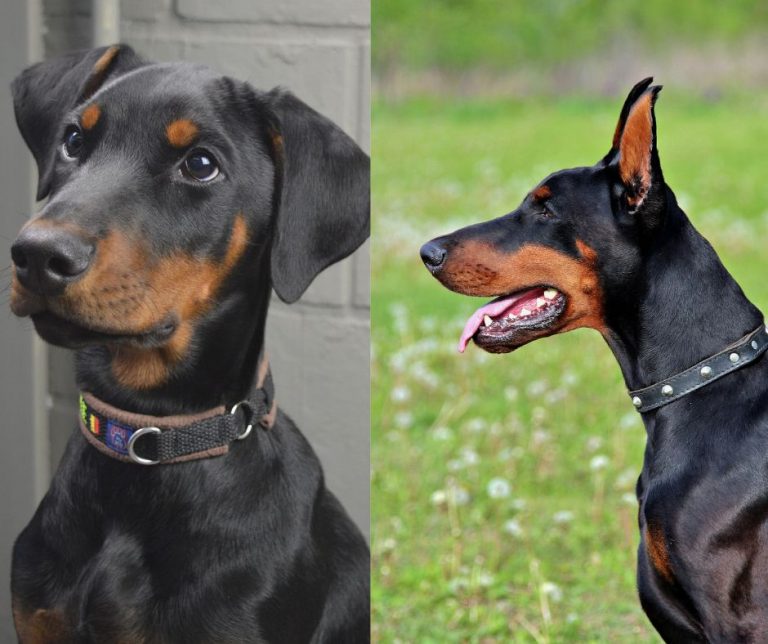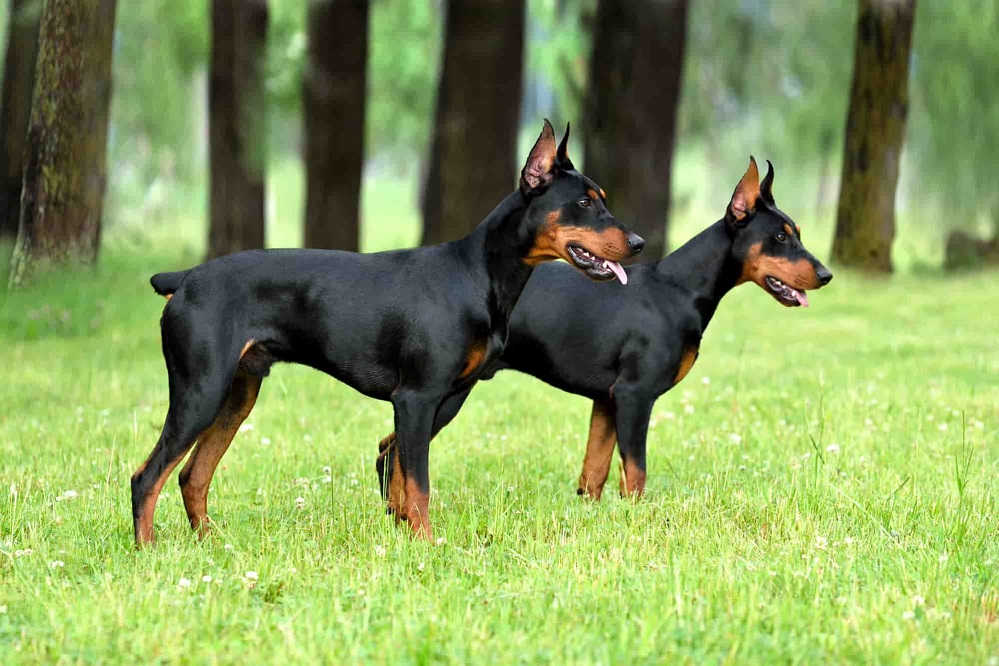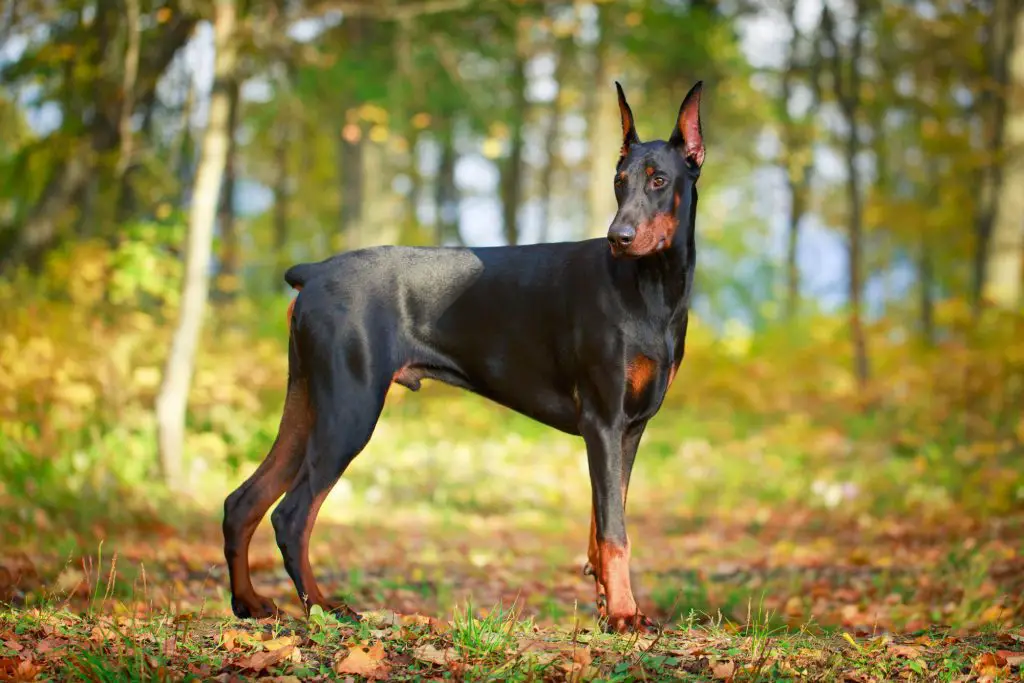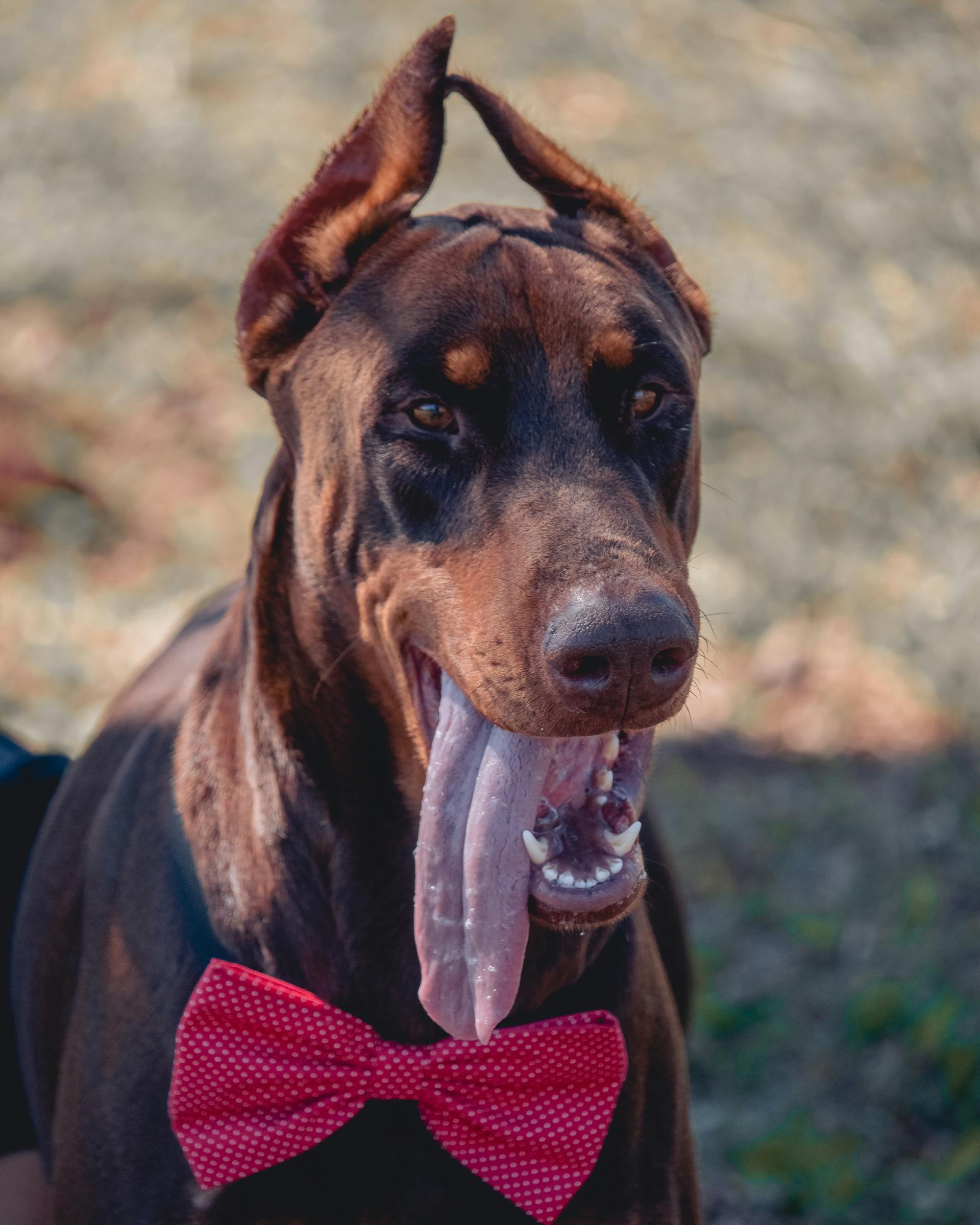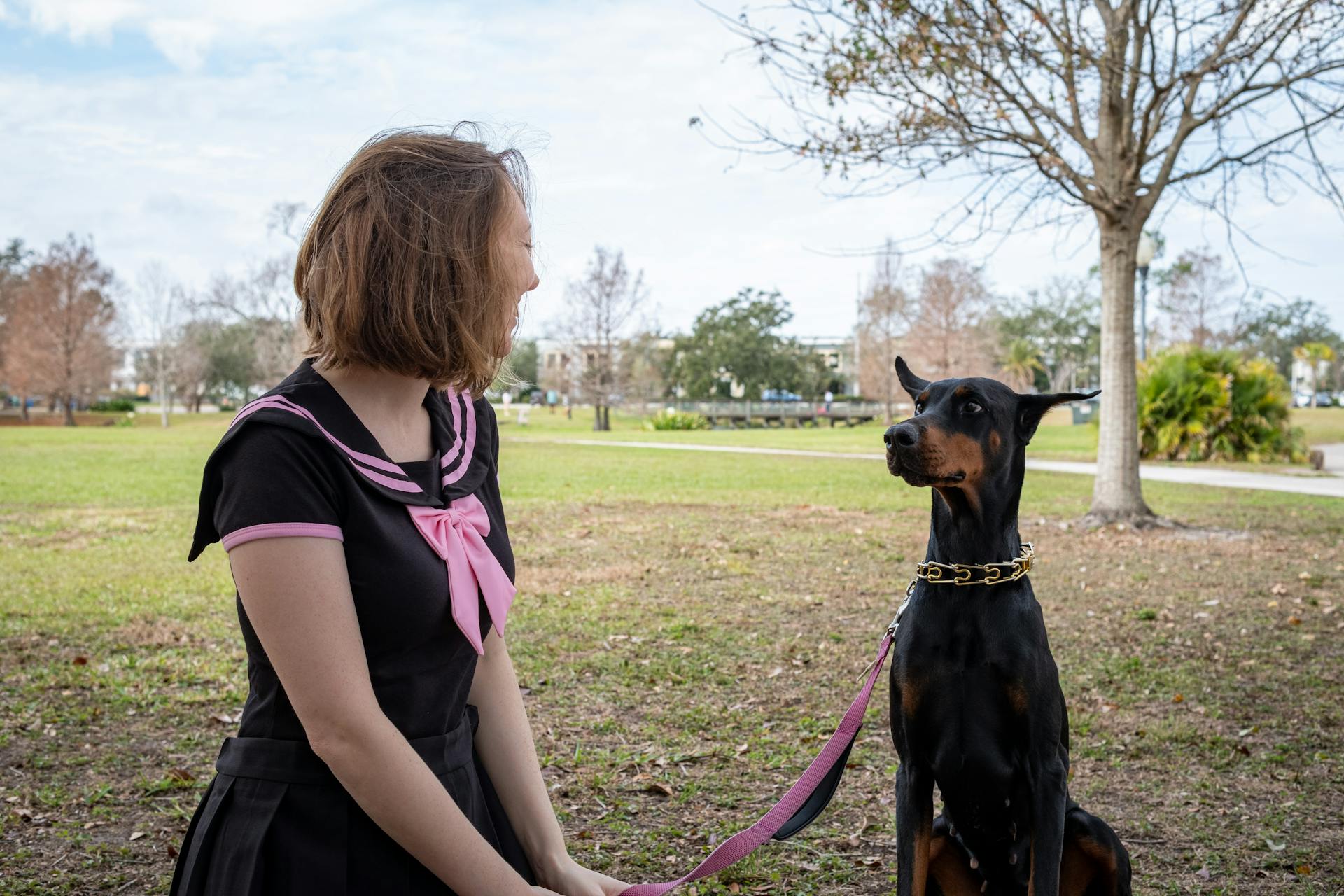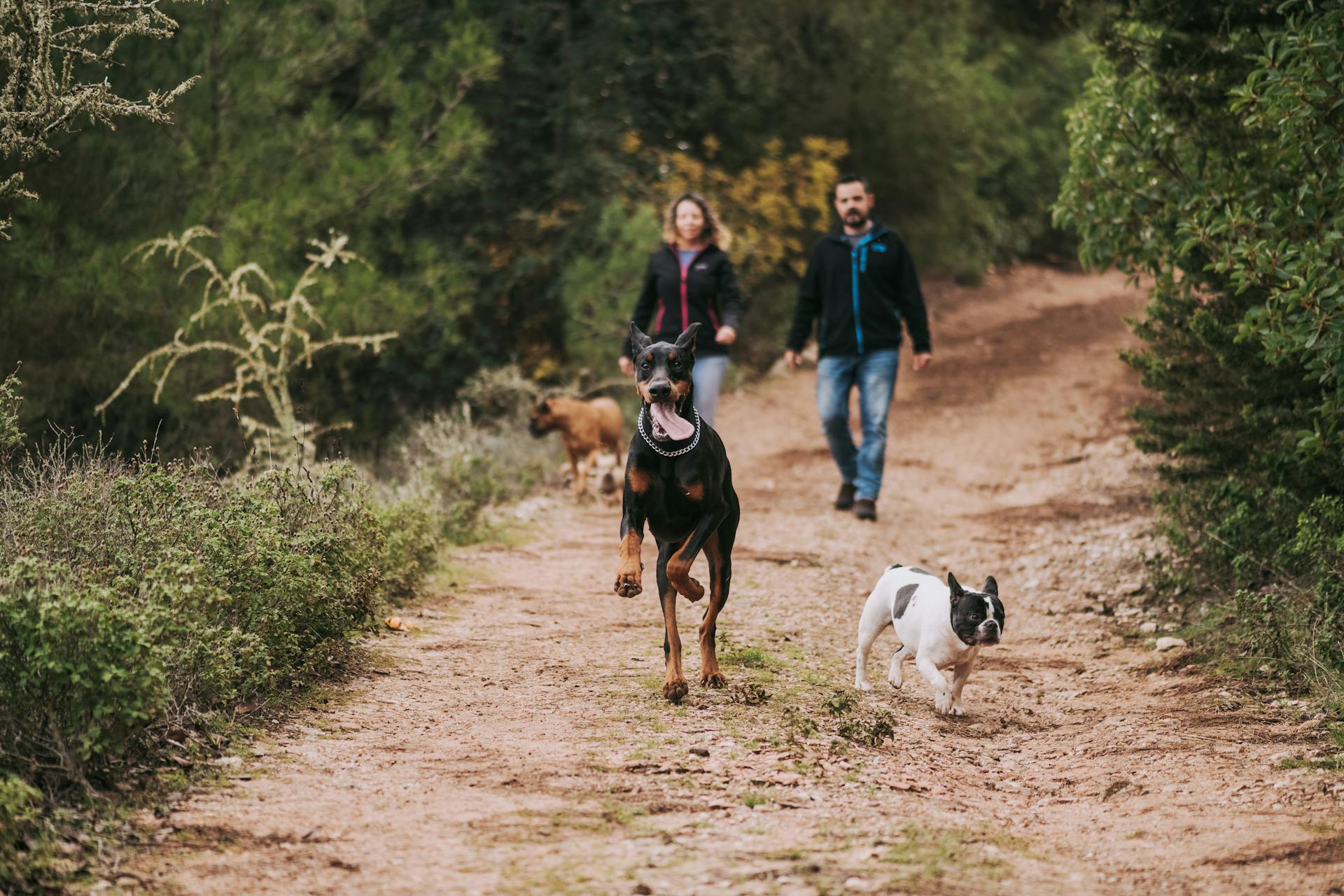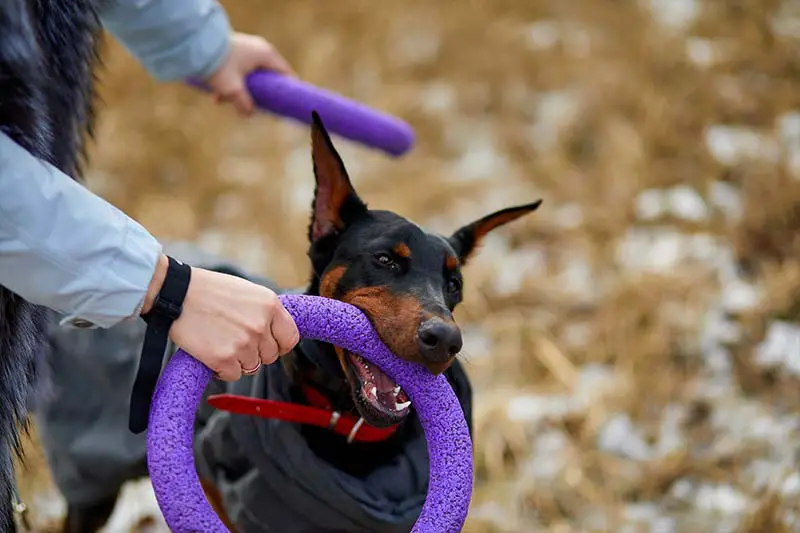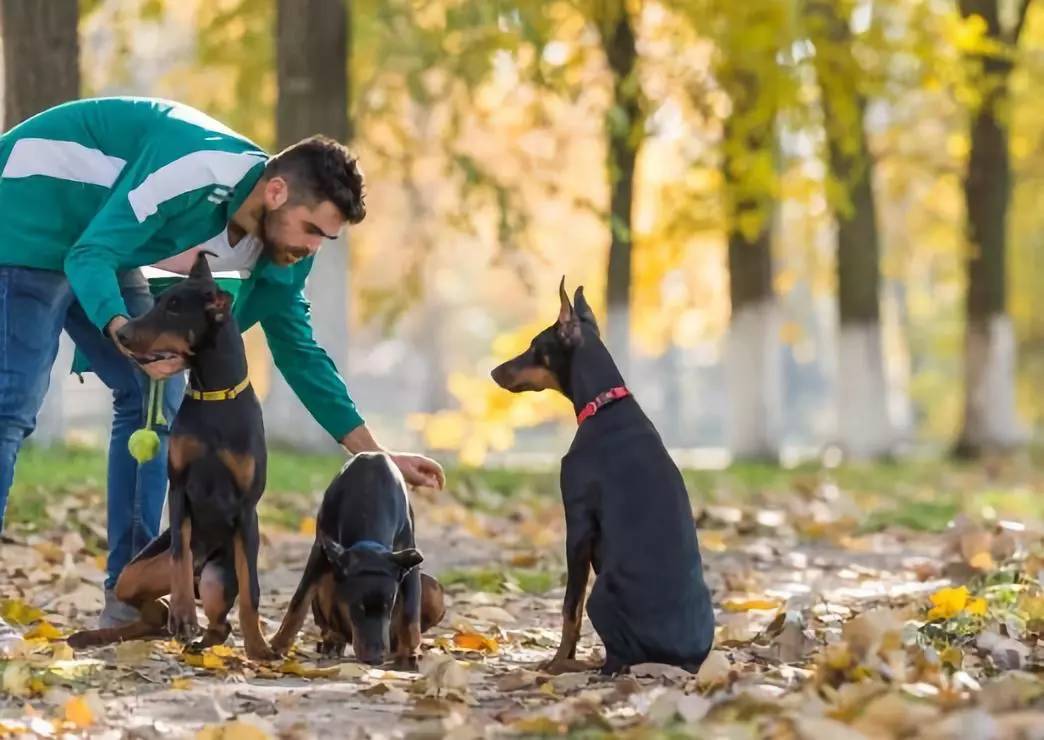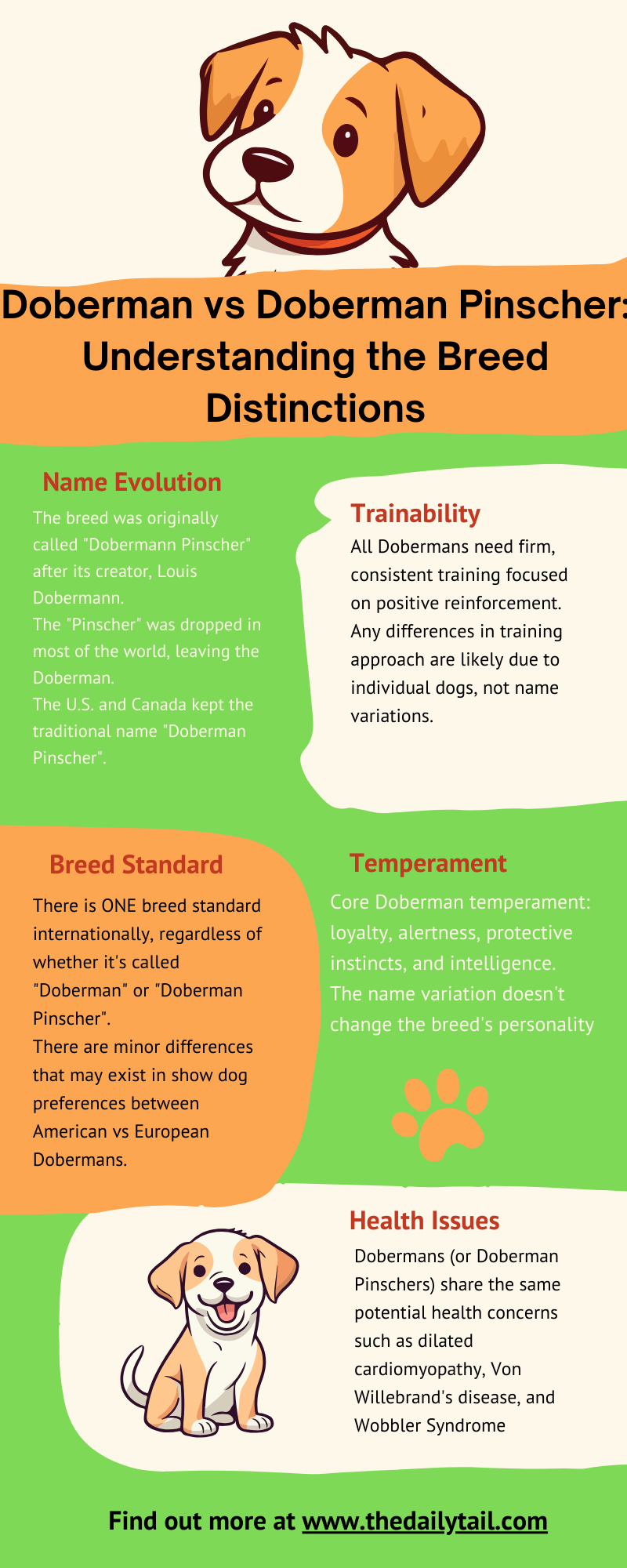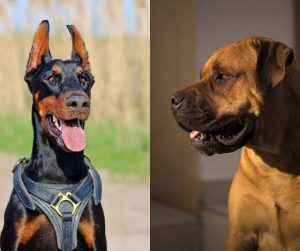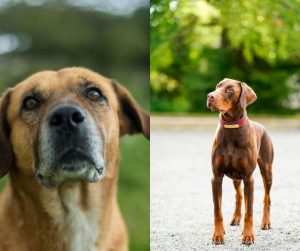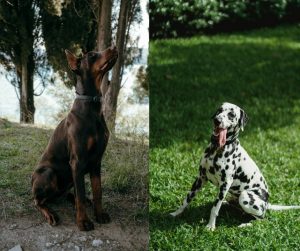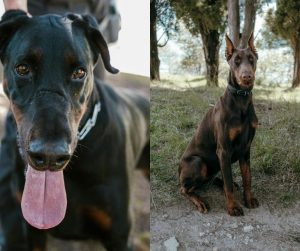Ever wondered why the Doberman is sometimes called a ‘Pinscher’? The answer might surprise you! Let’s dive into the story behind this iconic breed’s name.
When discussing the breed commonly known as the Doberman, it’s essential to understand that Doberman and Doberman Pinscher are two terms that refer to the same breed. Originating from Germany in the late 19th century, the breed was crafted by a tax collector named Karl Friedrich Louis Dobermann, who sought to create a medium-sized guardian dog to accompany him. The breed’s attributes include intelligence, strength, and loyalty, and they are distinguished by their sleek coat and athletic build.
There are subtle differences between the American and European varieties of this breed, which may sometimes lead to confusion. The American Doberman Pinscher tends to be slightly smaller with a more refined appearance; they often serve as companion animals. On the other side, the European Dobermann holds a more robust frame and may be more suited to work given their heightened drive and stamina.
Despite these differences, both varieties share the same breed standards according to major kennel clubs, ensuring that the Doberman name is recognized worldwide for its unique qualities.
In terms of temperament, Dobermans are renowned for their alert and loyal nature, making them well-suited for a variety of roles, including personal protection, police work, and as family pets. They are highly trainable, respond well to positive reinforcement, and require ample mental stimulation and physical exercise to maintain their well-being. Their care involves understanding their energetic profile and providing them with the necessary attention and engagement to thrive.
Let’s try and resolve the Doberman vs Doberman Pinscher dilemma.
Origins and History
The Doberman Pinscher breed has its roots firmly planted in Germany, accredited primarily to Karl Friedrich Louis Dobermann, a tax collector from the town of Apolda. In the late 19th century, he sought a canine that would ensure both protection and companionship during his high-risk profession. With this vision, Louis Dobermann began selectively breeding dogs around the 1890s.
His objective was to develop a breed that was intelligent, strong, and loyal. The result of his efforts led to the mix known today as the Doberman Pinscher, merging the best traits of various dogs, including the German Pinscher, Rottweiler, and Weimaraner amongst others.
In 1894, following Dobermann’s death, the breed carried his name as a tribute. It continued to evolve through the meticulous work of breeders. To formalize the breed, the first Doberman Pinscher club was established by Otto Göller, another local of Apolda, five years posthumously. This club laid down the breed’s first standard, which has since guided the development and preservation of the Doberman Pinscher characteristics.
| Year | Event |
|---|---|
| ~1890 | Louis Dobermann begins breeding the prototypical Doberman |
| 1894 | Louis Dobermann passes away |
| 1899 | The first breed standard for Dobermans is set |
Thus, the lineage of the Doberman and Doberman Pinscher—whether the breed is referred to with or without “Pinscher” in different parts of the world—traces back to Germany and the vision of Louis Dobermann, marking a distinct chapter in canine history.
Doberman Vs. Doberman Pinscher
The terms Doberman and Doberman Pinscher essentially describe the same dog breed, with the name varying by region. In the United States and Canada, the breed is commonly referred to as the Doberman Pinscher, while in other parts of the world, the name is shortened to Doberman.
Key Differences:
- Spelling Variants: The original German name has two ‘n’s (Dobermann) reflecting the last name of the breed’s creator, Karl Friedrich Louis Dobermann
- Regional Name Usage:
- United States & Canada: Doberman Pinscher
- Other Regions: Doberman
Physical Characteristics: Doberman Pinschers are known for their athletic build, sleek coat, and powerful appearance. They radiate confidence through their stance and movement.
| Characteristic | Description |
|---|---|
| Size | Medium to large breed |
| Build | Well-muscled, athletic |
| Coat | Short, comes in black, blue, red, fawn; low-maintenance |
| Appearance | Elegant, powerful, confident |
Though sometimes leading to confusion, there is no difference between a Doberman and a Doberman Pinscher beyond nomenclature. They share the same breed standard and are recognized by different kennel clubs under these two primary names interchangeably. Both exemplify a strong breed with a loyal and protective temperament, suitable for various work and companionship roles.
Breed Overview
This section provides insight into the specific characteristics and appearance that distinguish the Doberman breed, commonly referred to as Doberman Pinscher by some.
Characteristics
The Doberman is a breed renowned for its elegant yet powerful posture and demeanor. Typically, they exhibit a striking balance of strength and speed which contributes to their versatility in various roles. Their intelligence and loyalty make them excellent family pets as well as guard dogs, while their alertness and fearless nature suit working environments.
Appearance
- Size: The Doberman Pinscher stands tall with males typically measuring between 26 to 28 inches in height and females slightly smaller at 24 to 26 inches
- Weight: A healthy Doberman weight ranges from 60 to 100 pounds, with males generally being heavier than females
Coat & Color:
- The coat is typically short, sleek, and lies close to the body, offering a shiny and neat appearance
- Common coat colors include black, red, blue, and fawn, often accompanied by rust-colored markings on the face, chest, and legs of the dog
Their appearance is marked by a muscular build that manages to maintain elegance through its proportions, creating an overall impression of a well-designed, athletic canine.
Temperament and Behavior
The Doberman Pinscher exhibits a temperament that marries intelligence with loyalty, making them protective, yet affectionate family members. These dogs are widely recognized for their trainable nature and their need for consistent socialization to channel their high energy and prey drive in a positive direction.
Personality
The personality of the Doberman is complex yet well-balanced. They are highly intelligent and loyal to their family, often developing a strong bond with their owners. Known to be protective, they can be wary of strangers, which makes them excellent guard dogs. Their affectionate nature, however, shines through with those they consider part of their pack, displaying a fun-loving side that is endearing to family members.
Trainability
Dobermans are highly trainable due to their intelligence and eagerness to please. They thrive on mental challenges and do well with obedience training from an early age. Effective training methods include positive reinforcement and structured exercises that focus on consistent commands and routines. These dogs respond well to clear leadership and may present a challenge if not given proper direction, as they can develop stubborn or dominant behaviors.
Socialization
Proper socialization is critical for the Doberman to mitigate any predisposition towards aggression or fear-based responses. Introducing them to different people, pets, and environments early on helps develop a well-adjusted demeanor. They’re generally family-friendly when socialized correctly, capable of being gentle with children while also alert and vigilant. Due to their energy levels and potential prey drive, interactions with small pets should be carefully managed.
Health and Care
Proper health maintenance and grooming are vital for the wellbeing of Doberman Pinschers. They are generally healthy but can be prone to specific health issues which owners should monitor. Care routines including regular exercise and mental stimulation contribute to their physical and mental health.
Common Health Issues
Doberman Pinschers may encounter a few breed-specific health problems. Notably:
- Cardiomyopathy: The breed is susceptible to heart conditions, particularly dilated cardiomyopathy, which can be life-threatening if not properly managed
- Hip Dysplasia: An inherited condition where the thighbone doesn’t fit snugly into the hip joint
- Hypothyroidism: This hormonal issue can cause lethargy, weight gain, and coat problems
- von Willebrand’s Disease: A blood disorder that affects clotting can be found in this breed
Early detection and treatment of these health issues are crucial for the longevity and quality of life of a Doberman Pinscher.
Maintenance and Grooming
Regular maintenance and grooming are essential to keep a Doberman Pinscher healthy.
Coat Care:
- They have a short coat that requires minimal grooming
- Weekly brushing can reduce shedding and keep the short coat shiny
Exercise and Mental Stimulation:
- High levels of exercise are needed to maintain their muscular build and cardiovascular health
- Mental stimulation through training and problem-solving games prevent boredom and behavioral issues
Providing consistent care and monitoring will help ensure a healthy life for a Doberman Pinscher.
Physical Traits and Exercise Requirements
In discussing the physicality and activity needs of Dobermans, it’s essential to understand their build and energy levels directly influence their exercise requirements.
Activity Level
The Doberman Pinscher is a large working dog breed renowned for its athletic build and significant energy reserves. Standing between 24 to 28 inches at the withers and weighing between 60 to 100 pounds, they boast a sleek and powerful stature necessitating extensive exercise.
They require a high level of activity to satisfy their energetic nature. This includes:
- Daily vigorous exercise: Activities should be structured to enhance their cardiovascular health, such as daily walks or jogs
- Strength-focused workouts: Weight pulling to work out their robust muscles, preventing obesity and ensuring overall fitness
- Mental stimulation: Games and canine sports are vital, as they provide the necessary mental engagement for this intelligent dog breed
Neglecting the exercise needs of a Doberman can lead to behavioral problems, as they thrive on physical and mental challenges to keep them balanced. Therefore, prospective owners should be committed to an active lifestyle to meet the breed’s demands.
Doberman Pinschers in the Family
Doberman Pinschers are often recognized for their loyalty and devotion, making them well-suited as family pets. They are known to be gentle with their family members, affirming their reputation as protective yet loving dogs.
Children and Other Pets
Dobermans exhibit a strong sense of loyalty towards family, which usually extends to young children. They can be affectionate and gentle with kids, particularly if they are socialized from an early age. However, their large size and energetic nature mean supervision is recommended during interactions to ensure play remains safe and controlled.
- Interaction with Young Children: Gentle and patient, yet always supervised due to their strength
- Socialization: Crucial from an early age to promote positive behavior
With other pets, Dobermans can coexist peacefully, provided they have been properly introduced and socialized. They may have a high prey drive, so caution is advised, especially with smaller animals.
- Other Dogs: Can live amicably if introduced properly
- Smaller Animals: Potential for strong prey drive; interactions should be monitored
Family-friendly and with the proper training and socialization, a Doberman Pinscher dog breed can be a valuable and loving addition to the household. Their deep sense of devotion often translates to a protective nature over their family, while their intelligence makes them responsive to commands and boundaries set by their owners.
Training and Intelligence
The Doberman Pinscher exhibits a high level of intelligence, often ranked within the top echelons of canine intelligence rankings. Their acute alertness paired with intrinsic loyalty defines their character as a breed highly suitable for various forms of training.
Trainability is a standout characteristic of the Doberman Pinscher. They excel in obedience due to their eager-to-please attitude and respond exceptionally well to positive reinforcement techniques. Their cognitive abilities allow them to grasp complex commands rapidly, which is reflected in their performance in obedience trials.
Training should start early, employing consistent and patient methods. Due to their intelligence, Dobermans require mental stimulation to prevent boredom, which could lead to undesirable behaviors.
In specialized roles, such as search and rescue, the Doberman’s intelligence and trainability shine. Their ability to process complicated tasks, along with their physical prowess, makes them adept for this demanding and vital work.
| Aspect | Characteristic |
|---|---|
| Intelligence | High; able to learn complex tasks rapidly. |
| Obedience | Excellent; performs well in obedience trials. |
| Positive Reinforcement | Responds well; crucial for effective training. |
| Search and Rescue | Capable; suited for complex and critical roles. |
Their overall disposition towards training, paired with intelligence, positions the Doberman Pinscher as an extremely trainable breed, capable of achieving high levels of obedience and performing complex tasks in various demanding roles.
Breed Specific Legislation and Stigma
Breed Specific Legislation (BSL) has impacted dog breeds such as the Doberman Pinscher across various countries. Due to their history as guard dogs and their formidable appearance, Dobermans have sometimes been subject to stigma, with assumptions of aggression and fear towards them influencing such policies.
In some regions, this breed faces restrictions or bans, largely because of the perception that they pose a greater risk due to their protective instincts. For instance:
- Germany: Certain states have restrictions or prohibitions
- Ireland: Lists Dobermans among breeds with imposed restrictions
The enactment of BSL is frequently a controversial topic, as it targets specific breeds rather than addressing individual behavior or responsible ownership. Experts argue that legislation should focus on education and responsible pet ownership to mitigate issues of aggression, rather than stigmatizing breeds like the Doberman Pinscher.
The following points articulate key facts about the breed in relation to BSL:
- The Doberman Pinscher was originally bred for protection
- They are known for their loyalty, intelligence, and potential as guard dogs
- Negative stigma can arise from misunderstanding a Doberman’s protective behavior as undue aggression
- Advocacy for the breed emphasizes education on a Doberman’s nature and the importance of proper training and socialization
While BSL aims to protect communities, it is crucial to consider whether these laws are effective or merely a response to fear and misunderstanding of certain breeds like the Doberman Pinscher.
Kinship to Other Breeds
Before diving into a comparative analysis, it’s critical to recognize that the Doberman Pinscher is closely related to several other breeds, most notably the German Pinscher, from which it partially descends.
Comparative Analysis
The Doberman Pinscher’s genetics reveal a rich tapestry of contributing breeds beyond the German Pinscher, including the Rottweiler, Greyhound, and potentially the Miniature Pinscher, although the latter’s involvement is less certain. Specifically, the Rottweiler contributes robustness and strength, while the Greyhound offers speed and an elegant build.
- German Pinscher: The foundational breed, known for its medium size and courageous demeanor
- Rottweiler: Another contributor, lending the Doberman its considerable power and guardianship instincts
- Greyhound: Integrated for its sleek form and swiftness, enhancing the Doberman’s agility
One should not confuse the role of the Miniature Pinscher, despite the shared name “Pinscher,” as it is not a direct relative but rather a separate small toy breed with a distinct lineage.
With an understanding of these relationships, enthusiasts can appreciate the intentional breeding that led to the well-muscled and athletic Doberman Pinscher witnessed today.
Dobermans in Work and Service
Dobermans have a storied history as working dogs, both in service-oriented roles and in protection. Known for their intelligence and loyalty, Dobermans excel in various fields that require discipline and endurance.
American Doberman Pinschers tend to have a calmer temperament, which suits them for family-oriented service work. They often partake in therapy and assistive services, proving to be gentle and intuitive companions.
Contrastingly, the European Doberman is more robust and driven, making them ideal for jobs that demand a more assertive presence. Their work includes roles in search and rescue operations and as professionally trained guard dogs. Regardless of the variant, Dobermans share certain traits vital for service:
- Intelligence: They pick up commands and adapt to various tasks with remarkable acuity
- Focus: Their ability to concentrate on tasks makes them reliable in critical service roles
- Protective Nature: Innately vigilant, these dogs ensure the utmost protection for those they serve
In essence, whether it’s an American or European Doberman, their attributes are tailored to providing loyal and effective service across multiple disciplines.
Breed Variations and Standards
There are notable differences in breed standards between the American Doberman Pinscher and the European Dobermann. These variations extend beyond mere semantics and encompass distinctive aspects of their physical characteristics and temperament.American Doberman Vs. European Dobermann
- Ancestry and Appearance: Originating in the United States, the American Doberman Pinscher generally has a sleeker appearance, with a more refined bone structure, and is bred with a focus on a more elegant appearance in line with American Kennel Club standards
- Temperament: They tend to have a calmer personality compared to their European counterparts. This temperament, combined with a less heavyset frame, often makes them more suitable as companion animals rather than working dogs
European Dobermann:
- Ancestry and Character: The European Dobermann retains a closer link to the breed’s original German ancestry. It exhibits a more robust build, which is a reflection of the breed’s historical use as a personal protection dog
- Personality and Working Role: They are known for having a sharper temperament, indicative of their working-dog lineage. This makes the European Dobermann more assertive and suitable for roles in protection and law enforcement
Comparative Table:
| Trait | American Doberman Pinscher | European Dobermann |
|---|---|---|
| Build | Sleeker and more elegant | Robust and sturdy |
| Bone Structure | Finer | Heavier |
| Temperament | Calmer, companion-oriented | Sharper, work-oriented |
| Use | Show ring, family pet | Protection, police work |
The acknowledgement of these differences is crucial for potential owners, breeders, and enthusiasts who value the distinct qualities of the American Doberman Pinscher and the European Dobermann. It reflects on the individual’s preference for either a more composed personality and appearance, or a character aligning with professional work and protective instincts.
Finding a Doberman or Doberman Pinscher
When seeking a Doberman or Doberman Pinscher puppy, prospective owners should prioritize reputable breeders or adoption centers. Reputable breeders are knowledgeable about the breed and often provide health clearances for the puppies’ parents, reducing the risk of inherited conditions.
Where to Look:
- Registered Breeders: Ensure they follow ethical breeding practices
- Rescue Organizations: These may have Dobermans or Doberman Pinschers for adoption
- Local Shelters: Sometimes have purebred dogs available
Considerations When Choosing a Puppy:
| Feature | Doberman | Doberman Pinscher |
|---|---|---|
| Body Size | Larger, heavier | Slightly smaller, lighter |
| Energy Levels | High | High |
| Coat Colors | Black, red, blue, fawn | Same as Doberman |
| Health | Check breeding history for inherited conditions | Same as Doberman |
Before making a decision:
- Visit Multiple Sources: Visit more than one breeder or shelter to compare
- Ask for Documentation: Request health clearances and pedigree papers
- Meet the Puppy: Interact with the puppies to assess their temperament
- Consider an Adult Dog: An older dog can also be a great addition, often already house-trained and socialized
A key point is to not rush the decision. Whether the puppy is called a Doberman or a Doberman Pinscher, they share traits and need a committed owner ready for an intelligent and energetic companion.

